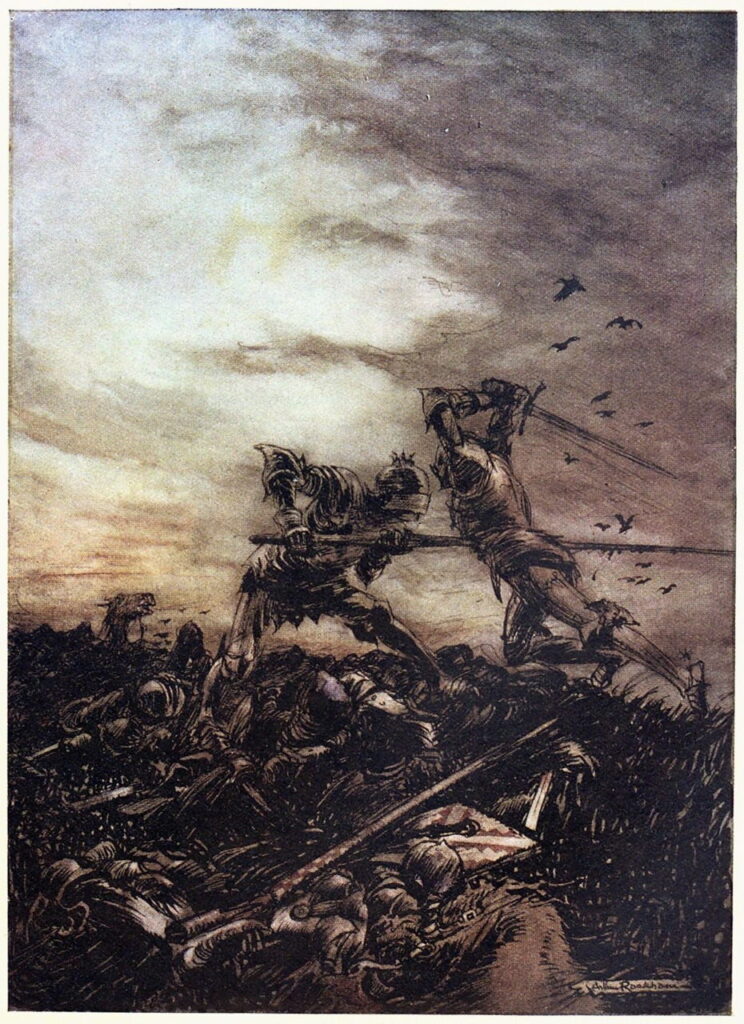Arthur: 12 Division and treachery

Returning to Malory’s account of Arthur, after the tragic death of Elaine the Fair Maid of Astolat, Queen Guenevere had asked Sir Lancelot for mercy over her previous anger towards him.
After Christmas, a great tournament was arranged between a group of kings and Arthur with his knights of the Round Table. Guenevere offered Lancelot a gold sleeve of hers to wear as a token of their relationship, which he accepted. When Lancelot was staying at a hermitage, he was wounded in his buttock by an arrow. Removing the head of that arrow proved difficult, he lost a lot of blood, and couldn’t sit in a saddle for a while. When it came to the tournament at Candlemas (2 February), he was still recovering, but with his relatives fought against King Arthur’s knights.
At the tournament King Arthur became angry that his knights were unable to gain any advantage over their opponents, and it was pointed out that they were fighting Sir Lancelot. As it was nearing the end of the day, the king had the horn sounded to tell all concerned to return to their lodgings. He caught up with Sir Lancelot, and they and the kings feasted well that night.
The following May, when she was riding out in the company of knights, Queen Guenevere was abducted by Sir Meleagant. As he was taking her away, she sent a messenger to inform Sir Lancelot, who immediately rode in pursuit of her. Eventually Lancelot arrived in Meleagant’s castle in the back of a cart, and the queen arranged a peaceful conclusion to her abduction.
When matters with Meleagant had been settled, Lancelot climbed a ladder to the window of the queen’s chamber, wrenched the bars clear of the window, and spent the whole night making love to her. The following morning, Sir Meleagant accused her of treason against King Arthur. Lancelot confronted him, and the two knights agreed to duel in a field outside Westminster in eight days time. But as he was walking to dinner, Lancelot fell through a trapdoor into a cave, where he remained trapped for days.
Each day Lancelot was fed by a maid, who warned him that unless he made love to her, he would stay there, and the queen would remain at risk of being burned at the stake for her treason. But Lancelot steadfastly refused the demand. Finally the maid agreed to enable his escape for the cost of just a kiss, and Lancelot relented. He dressed in his armour and rode off like a shot.
William Hatherell (1855-1928), The Rescue of Guinevere (1910), further details not known. Wikimedia Commons.
William Hatherell painted The Rescue of Guinevere in 1910, and I believe it refers to this episode, with Lancelot arriving and heading straight for Meleagant.
Lancelot arrived at Westminster just as Guenevere was being prepared to be burned at the stake, and was soon engaged in his duel with Meleagant. Once Lancelot had overwhelmed his opponent, he looked up to the queen to see from her signal whether he should finish Meleagant off. Although he interpreted that as a desire for the defeated knight to be killed, Lancelot offered to fight him with his left side unarmoured and his left arm bound behind him. Meleagant rose to this challenge, but it didn’t help in the slightest, and Lancelot quickly killed him.
Sir Mordred and Sir Aggravain, brothers of Sir Gawain, plotted to expose Lancelot’s affair with the queen. When they told the king, he demanded proof from them, by their catching him in the act. Accompanied by twelve other knights of the Round Table, Mordred and Aggravain caught Lancelot when he was without armour and unarmed in the queen’s chamber. Recognising his predicament, Lancelot made his farewells to the queen.
Julia Margaret Cameron (1815–1879), The Parting of Sir Lancelot and Queen Guinevere (1874), albumen silver print, 34.3 x 28.9 cm, J. Paul Getty Museum, Los Angeles, CA. Wikimedia Commons.
The pioneer photographer Julia Margaret Cameron showed the couple in her print of The Parting of Sir Lancelot and Queen Guinevere in 1874. Working mainly in her studio in Freshwater on the Isle of Wight, she posed friends and acquaintances to ‘re-enact’ such scenes in front of her camera.
As the knights outside started to batter the door to the chamber with a wooden bench, Lancelot opened the door sufficient to let the first of them in, killed him, dressed in that knight’s armour and brandished his sword. Lancelot then threw the door open and quickly killed all the other knights apart from Mordred, whom he wounded and put to flight.
Lancelot gathered a group of knights of the Round Table who were loyal to him, and they resolved that they would save the queen should Arthur intend that she be burned at the stake.
The wounded Mordred went to King Arthur and told him what had happened. Recognising that his Round Table was falling apart, Arthur sentenced Guenevere to death at the stake. Gawain spoke in favour of both the queen and Lancelot, but Arthur commanded him to execute the sentence. He refused, so the king sentenced him to death as well.
The following day Guenevere was led out to the stake dressed in her smock. Lancelot was informed immediately, and he and his group of knights rescued the queen, and took her away with them.
Arthur was a broken man. Twenty-four of his knights had been killed, and those who had survived were at war with one another. He decided to pursue Lancelot and Guenevere, and assembled all the forces he could to put siege to the castle of Joyous Gard where the couple were living together, protected by the knights loyal to them.
Lancelot remained in the castle for fifteen weeks, refusing to fight with King Arthur. Eventually they joined in battle, and Arthur was struck down. But Lancelot insisted that he wouldn’t be killed, put the wounded king back on his horse, and pleaded with him to end the fighting. Arthur rode off with tears in his eyes, regretting that the war had ever started.
News of this reached the Pope, who promptly sent an instruction that the two parties were to disengage and settle the matter peacefully, which they did in a formal ceremony where Lancelot returned Guenevere to a silent Arthur in front of all their knights. But Sir Gawain remained unmoved, and refused to make his peace with Lancelot. As a result, Lancelot returned to his castle after he had made his farewells to the queen. Once there, Lancelot consulted with his knights, and they agreed to leave the country and settle in Benwick (which Malory identifies as either Bayonne or Bordeaux, in France).
Sir Gawain pursued Lancelot with an army of sixty thousand, and laid siege to Lancelot’s lands in Benwick. Gawain accused him of being both a traitor and a coward, forcing them to fight one another. Eventually, with Gawain lying on the ground incapable of defending himself, Gawain told him to deliver the coup de grace, but Lancelot refused. As soon as Gawain had recovered from his wounds, this was repeated, and once again Lancelot refused to kill him.
While this was going on, Mordred usurped Arthur’s throne, had himself crowned King of England, and declared his intention to marry Guenevere. The Archbishop of Canterbury warned him that he would be cursed for marrying his own father’s wife (as Mordred was the illegitimate son of Arthur), and that Arthur was still alive, contrary to the rumours Mordred was spreading. The Archbishop excommunicated Mordred, and Guenevere made it known that she would rather kill herself than marry the usurper.
Although opposed by Mordred, Arthur landed at Dover with a large fleet. Among the casualties there was Gawain, who died after dictating a letter to Lancelot imploring him to come to the aid of King Arthur. Arthur’s army continued to pursue Mordred’s until they came together on a down near Salisbury, where the two agreed to fight one another. As they were facing each other, one of the knights present drew his sword to kill an adder that had bitten him. That was misinterpreted by the armies, and they erupted into full battle, leaving a great many dead.
King Arthur then saw Mordred and resolved to kill the traitor. The two locked together in combat, and Arthur drove his spear deep into his opponent’s body. In his last moments, though, Mordred struck his sword into Arthur’s head, before he fell dead.
Newell Convers (N. C.) Wyeth (1882–1945), “Then the king … ran towards Sir Mordred, crying, ‘Traitor, now is thy death day come.’” (1922), illustration p 306 of ‘The Boy’s King Arthur’, ed. Sidney Lanier, Charles Scribner’s Sons, New York. Wikimedia Commons.
N. C. Wyeth’s illustration from 1922 show the start of their duel, with Arthur charging at Mordred with his spear.
Arthur Rackham (1867–1939), [title not known] (1917), illustration for The Romance of King Arthur, Alfred W Pollard, Macmillan, location not known. Wikimedia Commons.Arthur Rackham’s illustration of this from 1910 is a stark sequel, as the impaled Mordred is about to bring his sword down on Arthur’s head.
King Arthur knew that he too was dying, and handed his sword Excalibur to Sir Bedevere, for him to throw it back into the lake from where it had come. But Bedevere couldn’t bring himself to throw that sword away. It was only on his third attempt that he finally threw the sword into the lake, and an arm appeared from the water, its hand grasped the sword and shook it three times before disappearing back into the water.
Reference
Dorsey Armstrong (translator and editor) & Sir Thomas Malory (2009) Morte Darthur, a new modern English translation, Parlor Press. ISBN 978 1 60235 103 5. (A superb translation based on the Winchester manuscript.)

